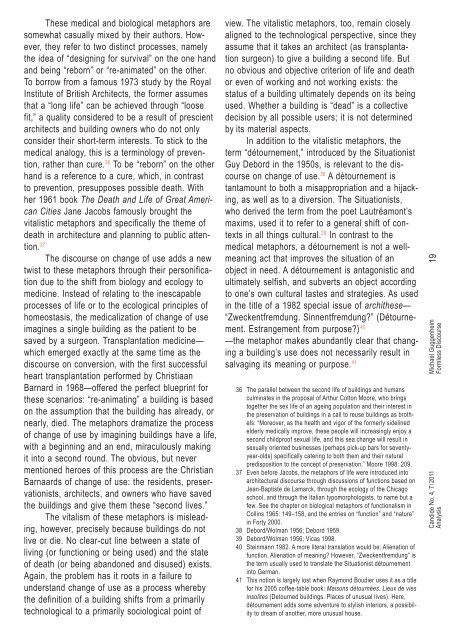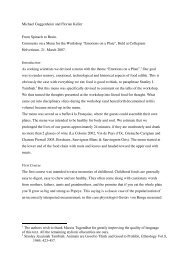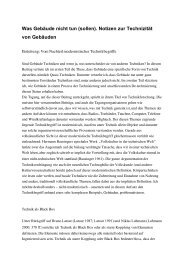Michael Guggenheim Formloser Diskurs. Umnutzung als Test ...
Michael Guggenheim Formloser Diskurs. Umnutzung als Test ...
Michael Guggenheim Formloser Diskurs. Umnutzung als Test ...
Sie wollen auch ein ePaper? Erhöhen Sie die Reichweite Ihrer Titel.
YUMPU macht aus Druck-PDFs automatisch weboptimierte ePaper, die Google liebt.
These medical and biological metaphors are<br />
somewhat casually mixed by their authors. However,<br />
they refer to two distinct processes, namely<br />
the idea of “designing for survival” on the one hand<br />
and being “reborn” or “re-animated” on the other.<br />
To borrow from a famous 1973 study by the Royal<br />
Institute of British Architects, the former assumes<br />
that a “long life” can be achieved through “loose<br />
fit,” a quality considered to be a result of prescient<br />
architects and building owners who do not only<br />
consider their short-term interests. To stick to the<br />
medical analogy, this is a terminology of prevention,<br />
rather than cure. 36 To be “reborn” on the other<br />
hand is a reference to a cure, which, in contrast<br />
to prevention, presupposes possible death. With<br />
her 1961 book The Death and Life of Great American<br />
Cities Jane Jacobs famously brought the<br />
vitalistic metaphors and specifically the theme of<br />
death in architecture and planning to public attention.<br />
37 The discourse on change of use adds a new<br />
twist to these metaphors through their personification<br />
due to the shift from biology and ecology to<br />
medicine. Instead of relating to the inescapable<br />
processes of life or to the ecological principles of<br />
homeostasis, the medicalization of change of use<br />
imagines a single building as the patient to be<br />
saved by a surgeon. Transplantation medicine—<br />
which emerged exactly at the same time as the<br />
discourse on conversion, with the first successful<br />
heart transplantation performed by Christiaan<br />
Barnard in 1968—offered the perfect blueprint for<br />
these scenarios: “re-animating” a building is based<br />
on the assumption that the building has already, or<br />
nearly, died. The metaphors dramatize the process<br />
of change of use by imagining buildings have a life,<br />
with a beginning and an end, miraculously making<br />
it into a second round. The obvious, but never<br />
mentioned heroes of this process are the Christian<br />
Barnaards of change of use: the residents, preservationists,<br />
architects, and owners who have saved<br />
the buildings and give them these “second lives.”<br />
The vitalism of these metaphors is misleading,<br />
however, precisely because buildings do not<br />
live or die. No clear-cut line between a state of<br />
living (or functioning or being used) and the state<br />
of death (or being abandoned and disused) exists.<br />
Again, the problem has it roots in a failure to<br />
understand change of use as a process whereby<br />
the definition of a building shifts from a primarily<br />
technological to a primarily sociological point of<br />
view. The vitalistic metaphors, too, remain closely<br />
aligned to the technological perspective, since they<br />
assume that it takes an architect (as transplantation<br />
surgeon) to give a building a second life. But<br />
no obvious and objective criterion of life and death<br />
or even of working and not working exists: the<br />
status of a building ultimately depends on its being<br />
used. Whether a building is “dead” is a collective<br />
decision by all possible users; it is not determined<br />
by its material aspects.<br />
In addition to the vitalistic metaphors, the<br />
term “détournement,” introduced by the Situationist<br />
Guy Debord in the 1950s, is relevant to the discourse<br />
on change of use. 38 A détournement is<br />
tantamount to both a misappropriation and a hijacking,<br />
as well as to a diversion. The Situationists,<br />
who derived the term from the poet Lautréamont’s<br />
maxims, used it to refer to a general shift of contexts<br />
in all things cultural. 39 In contrast to the<br />
medical metaphors, a détournement is not a wellmeaning<br />
act that improves the situation of an<br />
object in need. A détournement is antagonistic and<br />
ultimately selfish, and subverts an object according<br />
to one’s own cultural tastes and strategies. As used<br />
in the title of a 1982 special issue of archi these—<br />
“Zweckentfremdung. Sinnentfremdung?” (Détournement.<br />
Estrangement from purpose?) 40<br />
—the metaphor makes abundantly clear that changing<br />
a building’s use does not necessarily result in<br />
salvaging its meaning or purpose. 41<br />
36 The parallel between the second life of buildings and humans<br />
culminates in the proposal of Arthur Cotton Moore, who brings<br />
together the sex life of an ageing population and their interest in<br />
the preservation of buildings in a call to reuse buildings as brothels:<br />
“Moreover, as the health and vigor of the formerly sidelined<br />
elderly medically improve, these people will increasingly enjoy a<br />
second childproof sexual life, and this sea change will result in<br />
sexually oriented businesses (perhaps pick-up bars for seventyyear-olds)<br />
specifically catering to both them and their natural<br />
predisposition to the concept of preservation.” Moore 1998: 209.<br />
37 Even before Jacobs, the metaphors of life were introduced into<br />
architectural discourse through discussions of functions based on<br />
Jean-Baptiste de Lamarck, through the ecology of the Chicago<br />
school, and through the Italian typomorphologists, to name but a<br />
few. See the chapter on biological metaphors of functionalism in<br />
Collins 1965: 149–158, and the entries on “function” and “nature”<br />
in Forty 2000.<br />
38 Debord/Wolman 1956; Debord 1959.<br />
39 Debord/Wolman 1956; Vicas 1998.<br />
40 Steinmann 1982. A more literal translation would be: Alienation of<br />
function. Alienation of meaning? However, “Zweckentfremdung” is<br />
the term usually used to translate the Situationist détournement<br />
into German.<br />
41 This notion is largely lost when Raymond Boudier uses it as a title<br />
for his 2005 coffee-table book: Maisons détournées. Lieux de vies<br />
insolites (Detourned buildings. Places of unusual lives). Here,<br />
détournement adds some adventure to stylish interiors, a possibility<br />
to dream of another, more unusual house.<br />
19<br />
<strong>Michael</strong> <strong>Guggenheim</strong><br />
Formless Discourse<br />
Candide No. 4, 7 / 2011<br />
Analysis<br />
C4_5_<strong>Guggenheim</strong>_KF_2.indd 19 20.07.11 20:03







